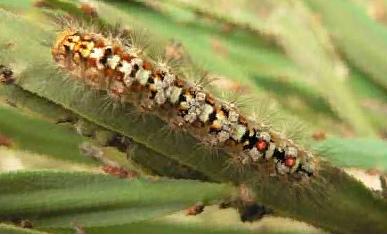Biodiversity in crisis
By Gayle Osborne

An amazingly colourful caterpillar on the leafless bossiaea (photo by Gayle Osborne)
The natural world, or in old fashioned terms, “Mother Nature” is an exquisite system. Evolved over billions of years, every microbe, insect, animal and plant performs a function that is linked to keep the system running.
We now call this biological diversity or biodiversity and it encompasses the variety of all life forms on earth - plants, animals and micro organisms, the genes they contain, and the ecological systems of which they form a part. It is a constantly changing and evolving system.
In order to increase worldwide awareness of biodiversity and its importance, and to engage more people in its conservation, the United Nations has designated 2010 as The International Year of Biodiversity.
In 2005 the United Nations reported that approximately 60% of global ecosystem services were being degraded or used unsustainably.
According to Prof. Brendan Mackey (Director, ANU WildCountry Research and Policy Hub) “By any measure, we are now in the midst of the 6th mass extinction of biodiversity in the history of the earth and the first to be driven by human activity.”
The loss of biodiversity threatens our health and wellbeing. The fertility of our land and the purity of our water are dependent on micro-organisms. Healthy ecosystems support food production and clean air.
Victoria, once a biodiversity paradise has “some 3,140 species of vascular plants, 900 lichens, 750 mosses and liverworts, 111 mammals, 447 birds, 133 reptiles and 33 amphibians as well as a large number of invertebrates, fungi and algae species, many of which are yet to be described.” (State of Environment)
However, under the stewardship of European settlement Victoria has become the most cleared state in Australia. We have removed 60% of our native vegetation and drained 35% of our wetlands. It should not surprise us that 44% of Victoria’s native plants and 30% of the State’s native animals are either extinct or considered under threat. Most of the clearing for agriculture has occurred in the western half of the State.
“Some 157 animal species are considered threatened in Victoria, while a further 24 have become extinct. In addition, 778 plant species are listed as threatened in Victoria, with 51 extinctions.” (State of the Environment)
The State of the Environment Report indicates that we are still losing native vegetation, existing vegetation is declining in quality, more native species are being added to threatened lists and climate change threatens many other species.
This is despite all the efforts of those involved in biodiversity conservation and plethora of environmental legislation, white papers and catchment management strategies and reports all highlighting the urgent need for action.
Unfortunately, in response to this the Victorian Government has failed to commit adequate resources to ensure that biodiversity is conserved. Instead there is a heavy reliance on seeking private investment under the guise of ‘fostering environmental markets and leveraging investment’. The Australian public seems to remain largely unaware of the crisis, or the fundamental role biodiversity plays in the health of the planet.
There is an urgent need for better public education on the vital role biodiversity plays in sustaining all life and human societies, and a substantial (tenfold) increase in resources to address the crisis we all face.
We hope that the designation of 2010 as the International Year of Biodiversity will give groups like Wombat Forestcare the opportunity to raise these issues locally, to promote the importance of the Wombat Forest and to lobby for the protection of existing flora, fauna and ecosystems.
References
State of the Environment Report – Victoria 2008 Environmental Sustainability Issue Analysis for Victoria - CSIRO 2004
